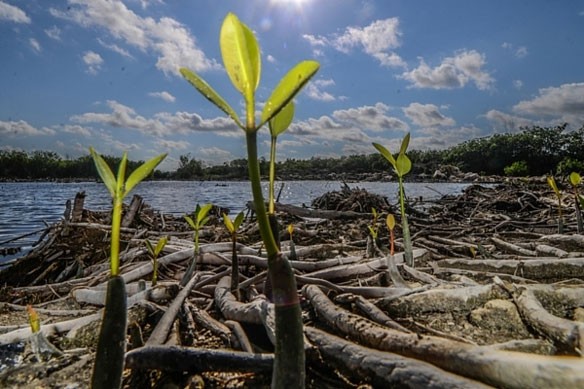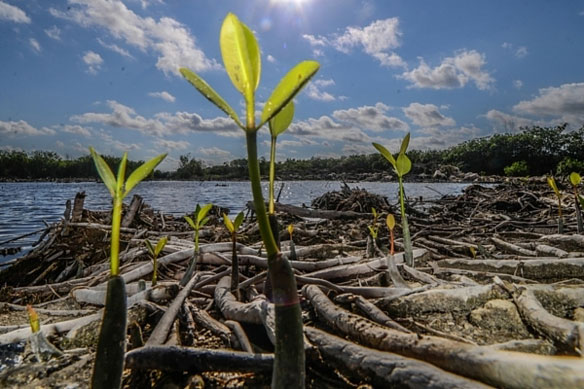
Photo source: Carlos Matus for Greenpeace
Just a month ago, if you passed by Tajamar in Cancún, Mexico you would have seen 57 hectares of thriving mangrove forest lining the coast. Today, only stumps remain.
For years, hundreds of citizens – including a group of children – worked to protect the Tajamar mangroves, one last swathe of wetlands in tourist-dominated Cancún. But in the middle of the night on 16 January, developers hoping to build a new resort – “Malecón Tajamar” – made their move. Under cover of darkness, they tore down the mangroves.
Local authorities allowed this destruction despite evidence that those promoting the resort had provided highly irregular information – even denying the mangroves were there at all.
Ultimately, the battle between these profit-driven developers and the local community came down to one question: what’s a mangrove worth?
Local government officials and developers touted the number of construction jobs and the income this new resort would produce. But they ignored the mangroves’ social, environmental and economic value – the heart of community protests.
Mangroves are a part of the natural ecosystem in Cancún, home to crocodiles, iguanas, birds, snakes and other species. Losing that biodiversity is devastating, and it’s only part of the story. The economic and social costs of losing the mangroves are staggering as well.
The National Commission for the Use of Biodiversity (CONABIO) estimates that mangroves produce about US$37,500 per hectare per year for fisheries; US$6,700 for health services in Mexico (that figure would reach US$200,000 in some cities of the country). And the protection offered by the coast from storms, cyclones and tsunamis is estimated to be about US$3,000 per hectare.
But officials in Mexico and other countries around the world continue to undervalue the services wetlands provide. Over the last few decades, Mexico has lost more than 35 percent of its mangroves due to logging, climate change and coastal development. Meanwhile, flooding is noticeably more frequent in areas that have lost this natural barrier.
Power of community activism
When the local protesters in Cancún first heard the mangroves had been destroyed, their reactions were immediate – to document the destruction that had occurred in secret.
Here are just some of the images they captured…
Later, federal officials attempted to downplay the damage to the mangroves, but because of the quick actions of the public, there was clear evidence of full extent of the damage to the Tajamar mangroves.
Hope grows for Tajamar
The Tajamar mangroves had already been decimated, but the fight is far from over. After their destruction became public knowledge, thousands of people across Mexico stood with the community protesters in outrage. And their voices made a huge impact.
Just this week, in response to a case brought to court by Greenpeace Mexico and ally organisations, a judge ordered a moratorium on all work for the Tajamar project. This is a huge victory for people and the environment over the private interests of a few.
However, the road is long before the project is truly cancelled. The Mexican government now has the opportunity to permanently end the project and begin restoration, or to allow the construction of more buildings whose service to the community could never equal the costs of the mangrove forests they replace.
But if officials choose money over mangroves again, they can be sure to expect more public attention – from local communities, and people around the world.
There is even new hope for the Tajamar. Now that construction is suspended, the mangroves have a chance to recover.
Original Article And Learn More, Greenpeace
Mexican court rules against development in Cancun mangrove, NZ Herald (02-05-2016)
A Mexican court has issued an injunction blocking further work on a real estate project in the Caribbean coast resort of Cancun that activists say has almost killed a mangrove swamp at the site. Heavy machinery largely cleared the mangrove trees from the area known as Nichupte lagoon in January, over the objections of local environmentalists. But environmentalists expressed hope after the order was announced that the mangrove can be recovered now that a court has ruled the project violated the public interest in preserving the wetland…
The Mexican Government Greenlights the Destruction of Mangroves, Vice News (01-20-2016)
Environmental activists are furious at the destruction of 143 acres of mangrove forest in order to build offices, apartments, shopping malls, and a huge church in the luxury resort of Cancún.The controversial project known as “Malecón Tajamar” is being promoted by the Mexican tourist board, known as Fonatur, and involves 23 private companies…
Destruction of Mangroves Costs up to US$42 billion in Economic Damages Annually – UNEP Report (10-14-2014)
The world is losing its mangroves at a faster rate than global deforestation, the United Nations revealed, in a new report “Importance of Mangroves: A Call to Action,” adding that the destruction of the coastal habitats was costing billions in economic damages and impacting millions of lives…
Mangroves Help Protect Against Sea Level Rise, Science Daily (07-27-2015)









